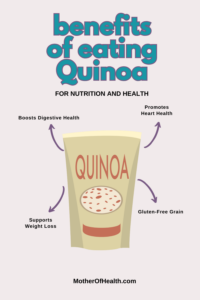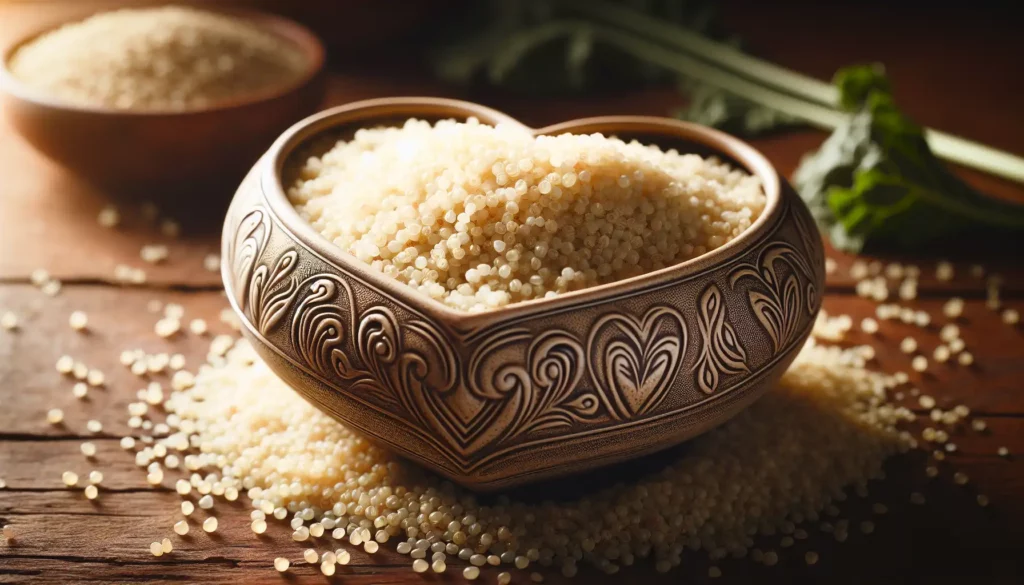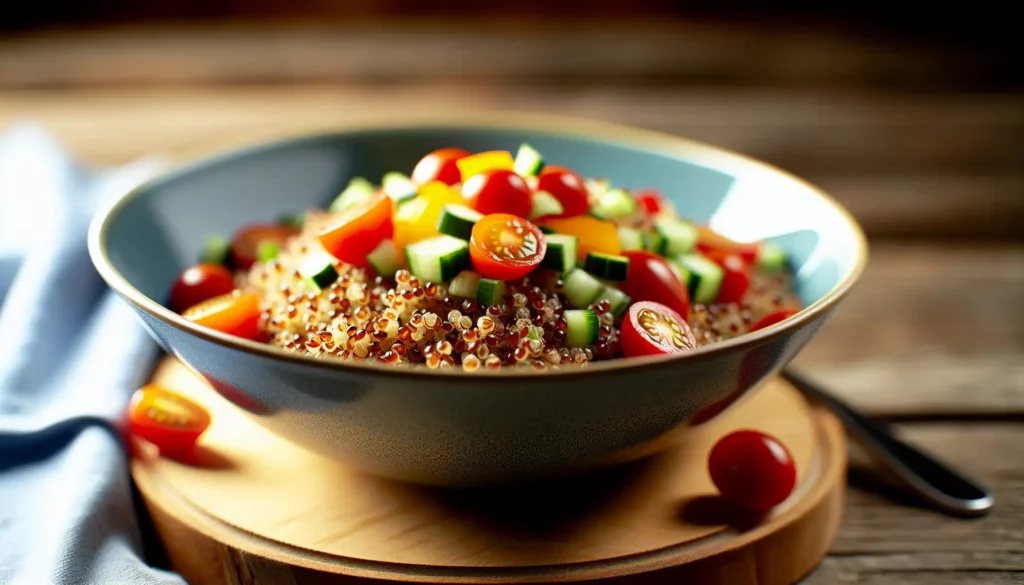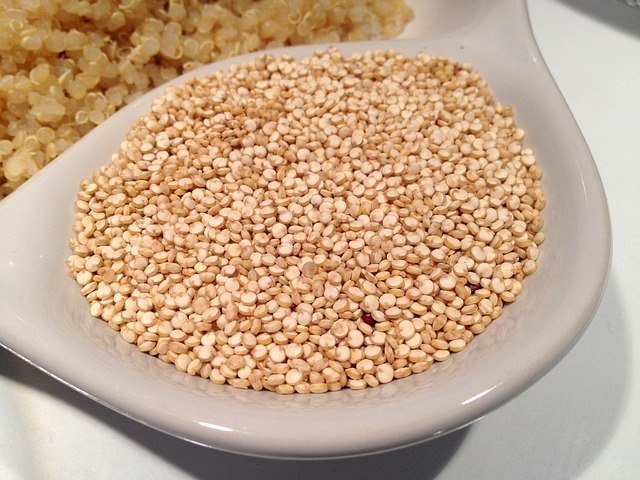Wondering why quinoa is revered as a health-packed seed? Its health benefits are vast, including complete proteins for muscle growth, better heart and digestive health, and help in managing weight and sugar levels. This article walks you through the impressive health benefits of quinoa, showing you why it’s a smart choice for your meals.


Key Insights
→Quinoa is a nutrient-dense, gluten free pseudo cereal. It offers a complete protein source with all nine essential amino acids, making it beneficial for vegans and those with gluten intolerance.
→Adding quinoa into your diet can enhance digestive and heart health due to its high fiber and healthy fats content. It also aids in weight management and blood sugar regulation given its low glycemic index and satiating properties.
→Though quinoa is versatile in cooking and has many health benefits, it should be eaten in moderation and prepared properly. It is recommended to rinse and soak quinoa to reduce potential saponins-related to digestive discomfort or allergic reactions.
The Power of Quinoa: A Nutrient-Packed Seed

An edible seed that comes from the Chenopodium Quinoa plant, quinoa is often referred to as an “ancient grain” due to its long history of cultivation. But it's actually a pseudo-cereal, more closely related to spinach and beetroot than to cereal grains. It's seeds are packed with dietary fiber, protein, and essential amino acids, making it a robust source of nutrition.
The germ of the grain is nearly 60% of the whole, makes quinoa's remarkable protein-to-carb ratio. This composition, along with the presence of all nine essential amino acids, makes Quinoa a unique plant-based complete protein source. It also offers a great alternative to gluten containing grains.
With over 120 varieties available globally, quinoa, particularly red, white, and black quinoa, provides a wealth of culinary possibilities.
Quinoa's Rich History in South America
Quinoa’s roots stretch deep into South American history, where it held a place of prominence in Incan culture. Revered as ‘chisoya mama’ or the ‘mother of all grains’, it served as a dietary staple and was used in sacred rituals.
The Incas recognized the nutritional value of quinoa and utilized it in ceremonies. The Sapa Inca would plant the first seeds of the season with golden tools, praying for a prosperous harvest.
Beyond its cultural importance, quinoa was a vital component in the survival tactics of ancient Andean societies. Paired with potatoes and llama meat, quinoa’s nutrient-dense profile sustained the Tiwanaku civilization for 2,500 years. This ‘ancient grain’ has been cultivated in the South American Andes since 5000 B.C. to 3000 B.C. This confirms the long-standing relationship between quinoa and human health.
Nutrient Profile: Essential Amino Acids and More
The nutrient profile of quinoa is noteworthy. It boasts all 20 amino acids, inclusive of the nine essential ones that our body can’t produce independently. This makes it one of the few plant foods that offer a complete protein source. This is an especially important feature for vegans and those on plant-based diets.
But the benefits of quinoa don’t stop with protein. It’s also rich in:
- dietary fiber
- magnesium
- manganese
- phosphorus
- folate
among other essential micronutrients. A single serving of cooked quinoa contains 5.18 grams of fiber, contributing to your daily dietary fiber requirements.
Health Benefits of Incorporating Quinoa into Your Diet

Adding Quinoa to your diet can result in many health advantages. Here are some of the benefits:
- Its high fiber content boosts digestive health, enhancing gut bacteria diversity and functioning as a prebiotic.
- Quinoa contains healthy fats, including small amounts of omega-3 fatty acids and a higher content of monounsaturated fat compared to many cereals. These contribute to heart health.
- Quinoa’s high protein and fiber content, coupled with its low glycemic index, support weight management and blood sugar control.
Quinoa’s fiber content aids in maintaining regularity, fending off constipation, and enhancing gut bacteria diversity. These benefits are particularly important for people with digestive issues or those looking to improve their overall gut health.
Quinoa provides several health benefits, including:
- Beneficial fats such as monounsaturated fat and omega-3 fatty acids, contributing to cardiac health
- High protein and fiber content, aiding in appetite management
- Low glycemic index, helping to regulate blood sugar
Boosts Digestive Health
The high fiber content in quinoa can possibly boost gut health by encouraging diversity of gut bacteria. It acts as a prebiotic, promoting the growth of beneficial gut bacteria to maintain a balanced digestive ecosystem.
The high fiber content in quinoa supports digestion by promoting bowel regularity, reducing constipation and bloating, and helping to regulate blood sugar levels, which contributes to a feeling of fullness and satisfaction after meals.
Promotes Heart Health
Quinoa’s heart-healthy fats play a significant role in promoting cardiovascular health. Here are some of the benefits:
- The omega-3 fatty acids found in quinoa, particularly α-linolenic acid, have been linked to cardiovascular health benefits, reducing inflammation and enhancing heart health.
- Monounsaturated fats such as oleic acid in quinoa also contribute to overall cardiovascular wellbeing.
- These fats, in combination with the omega-3 fatty acids present in quinoa, promote a healthy heart.
Additionally, the high dietary fiber content in quinoa may lower total and LDL cholesterol levels, consequently promoting overall heart health.
Supports Weight Loss and Blood Sugar Regulation
Quinoa’s high protein and fiber content can help manage weight and control blood sugar levels.
The fiber content in quinoa slows down the absorption of sugar into the bloodstream, thus aiding in the maintenance of stable blood sugar levels. Taking high fiber diet like quinoa can help with weight management by inducing a sensation of fullness. This can decrease calorie consumption.
The combination of quinoa’s low glycemic index, protein, and fiber content helps to decelerate digestion and curb sudden hunger pangs. The result is weight control and better regulation of blood sugar.
Quinoa: A Versatile Ingredient for Sweet and Savory Dishes

Quinoa's versatility in the kitchen is a key factor in its rising popularity. It can be used in many culinary creations, including:
- Breakfast porridge
- Salads
- Stir-fries
- Baked goods
Whether you’re seeking to add a nutrient boost to your meals or exploring gluten-free alternatives, quinoa is a reliable choice.
It can be boiled for salads and bowls, toasted for added crunch, or used as a base for pizza crusts and meatloaf, making it adaptable to a wide range of recipes.
International cuisine features a diverse array of quinoa-based dishes. Examples include Peruvian quinoa salads, Cinnamon Apple Quinoa Parfaits, and Mediterranean Quinoa Salads.
Cooking Techniques for Perfect Quinoa
- Rinse quinoa to cut the naturally occurring bitter compounds called saponins.
- Pre-soak quinoa in water for 12-24 hours
- Drain and rinse quinoa again before cooking
Following these steps will ensure that you cook quinoa to perfection.
The recommended water to quinoa ratio is 2 cups of water for every 1 cup of uncooked quinoa. The cooking time varies from 15-20 minutes. You'll know your quinoa is cooked perfectly when the germ around the seed separates and curls. It will appear popped open.
Recipe Ideas: From Salads to Baked Goods
Whether you're just starting to experiment with quinoa or you're a seasoned quinoa chef, there's no shortage of recipe ideas. Quinoa serves as a versatile and nutritious foundation for breakfast bowls.
Try a Butternut Squash Quinoa Breakfast Bowl or a Healthy Chocolate Quinoa Breakfast Bowl to start your day. For a light and nutritious lunch or dinner, Quinoa Salad with Asparagus, are all delicious recipes!
Quinoa can also be a versatile addition in stir fry dishes. It offers the option to combine it with vegetables or use it as a substitute for rice.
For dessert, quinoa can be used in a variety of dishes. Quinoa Pudding with Coconut Milk and Maple Syrup to Chocolate Cake with Quinoa and Gluten-Free Orange Cake are a few favorites.
Quinoa: A Gluten-Free Alternative for Those with Celiac Disease and Gluten Intolerance
It can be challenging for people with celiac disease or gluten intolerance to find nutritious, gluten-free substitutes. Enter quinoa, a naturally gluten-free and rich alternative, delivering essential nutrients such as:
- protein
- iron
- calcium
- fiber
Compared to refined gluten-free alternatives, quinoa is a more favorable option for promoting gut and digestive health.
Substituting quinoa for grains such as rice can contribute to a more balanced diet for those with celiac disease and others following a gluten-free diet. Even those with celiac disease can safely eat quinoa on a daily basis.
The Importance of a Balanced Gluten-Free Diet
For those with Celiac disease, maintaining a balanced gluten-free diet is vital for health. Essential to this diet is the prioritization of naturally gluten-free foods including:
- meat
- fish
- fruits
- vegetables
- rice
- potatoes
- dairy
- beans
- legumes
- nuts
Quinoa, being a gluten-free grain, can fill nutritional deficiencies in a gluten-free diet. It contains high levels of folic acid and can serve as a valuable source of iron for those with celiac disease. Other recommended foods to incorporate into a well-rounded gluten-free diet include:
- legumes
- nuts and seeds
- red meat (if you are not vegetarian or vegan)
- poultry
- rice
- millet
- oats
Quinoa Flour: A Versatile Option for Gluten-Free Baking
For those who love baking but need to avoid gluten, quinoa flour presents a tasty and nutritious alternative.
Quinoa four is made by milling dried quinoa seeds or quinoa flakes into a powdery texture. It's a flavorful substitute for wheat flour. It's nutritional profile includes:
- Lower calorie content
- Higher levels of nutrients, including sodium, potassium, magnesium and calcium
- A significant source of fiber
- Various vitamins and minerals
The high protein and fiber content of quinoa flour can enhance the structure of gluten-free baked goods.
There are several delicious gluten-free baking recipes that use quinoa flour, including flour biscuits. Adding quinoa flour biscuits daily into your diet can provide a wonderful alternative to traditional baked goods.
Some other recipes to try are:
- Chocolate chip cookies
- Quinoa brownies
- Lemon berry muffins
- Chocolate chip banana bread
- Gingersnap cookies
Quinoa seeds contain essential amino acids like lysine, tyrosine, and tryptophan. What's interesting is that a study showed that deficiency of essential amino acids can lead to nervousness, exhaustion, and dizziness. But thankfully even a moderate consumption of Quinoa can help avoid such symptoms.
Potential Downsides and Precautions When Adding Quinoa to Your Diet
Despite the multitude of health benefits of quinoa, it also comes with potential drawbacks.
Saponins, the naturally occurring bitter compounds in quinoa, can be toxic in high concentrations. This could cause adverse reactions in some people. Yet, saponins can be removed by rinsing or presoaking the seeds.
Cases of allergic reactions to quinoa are infrequent. But sensitive people may experience adverse reactions due to the saponins. Symptoms of an allergic reaction to quinoa may include coughing, difficulty swallowing, throat tightness, stomach cramps, upset stomach, indigestion, diarrhea, vomiting, itchy skin, abdominal pain, and hives.
Eating quinoa in moderation is necessary to uphold a balanced diet and guarantee enough intake of other essential nutrients.
Saponins and Allergic Reactions
Saponins in quinoa can cause an allergic reaction in some people. Symptoms of an allergic reactions to quinoa include:
- hives
- eczema
- swelling around the lips or mouth
- upset stomach
- coughing
- difficulty swallowing
- hoarse throat
- stomach cramping
While quinoa allergies are not well-documented, there have been reports of sensitivity to quinoa. In some instances, there are reports of cross-reactivity with peanut and tree nut allergens.
To avoid reactions, quinoa should be thoroughly rinsed with water, followed by a pre-soak in water for 12-24 hours. Then do another round of draining and rinsing to get rid of the saponins.
Moderation is Key: Balancing Quinoa Intake with Other Nutrient Sources
Despite the many health benefits of quinoa, it should be eaten in moderation. The suggested daily servings of quinoa for a balanced diet range from 1/3 cup to 3/4 cup. Excessive intake of quinoa can lead to digestive issues such as:
- stomach ache
- diarrhea
- bloating
- discomfort
This is due to its high fiber content.
Some alternatives to quinoa for a balanced diet include rice, particularly brown rice and couscous.
It's also important to note that quinoa's mineral content, such as iron, calcium, magnesium, and zinc is relatively low due to the presence of phytates, which can hinder the absorption of these essential minerals.
Summary
In conclusion, quinoa is a nutrient-dense, versatile, and gluten-free seed that can be a valuable addition to your diet.
It's rich history in South America, it's many health benefits from promoting digestive and heart health to supporting weight loss and blood sugar regulation, and its culinary versatility make it a true superfood.
Yet, like all foods, it should be consumed in moderation and balanced with other nutrient sources.
Frequently Asked Questions

Can I eat quinoa everyday?
Eating quinoa daily is generally healthy, but consuming excessive amounts could lead to digestive issues. It's safe to eat one to two cups of cooked quinoa per day, as recommended by the Harvard Public School of Health
Is quinoa really a superfood?
Yes, quinoa is considered a superfood due to its high nutritional content and versatility in cooking. It's a nutritional powerhouse and a great addition to your diet.
Is quinoa actually healthier than rice?
Yes, quinoa is generally considered healthier than rice due to its high protein, fiber, iron, calcium, magnesium, phosphorus, potassium, and zinc content. While both are nutritious, quinoa offers more health benefits.
Is quinoa a carb or protein?
Quinoa is primarily considered a carbohydrate due to its high carb content per serving, although it also contains some protein. Its macronutrient distribution resembles that of other grains and starches.
What nutrients are present in quinoa?
Quinoa is rich in dietary fiber, complete protein, essential amino acids, and micronutrients like magnesium, manganese, phosphorus, and folate, making it a highly nutritious food choice.


